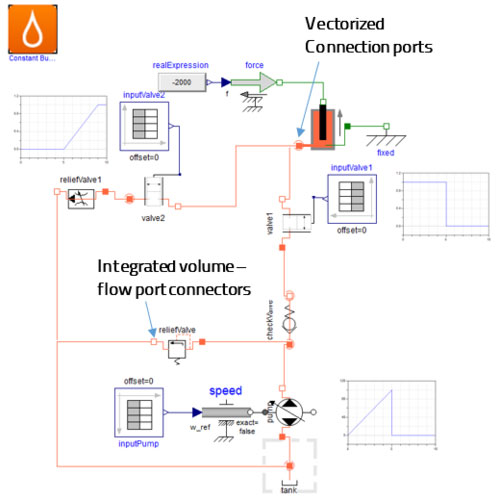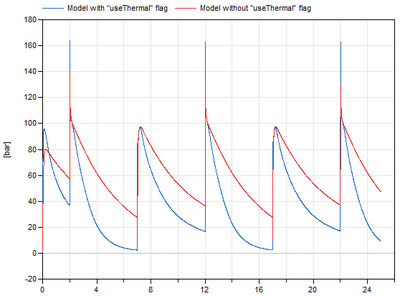油圧ライブラリの熱流体力学システム表現機能を向上

The Modelon Hydraulics Library introduces improved handling of thermodynamic effects by including a new concept of flexible thermohydraulic ports.
During the design of a hydraulic system, many questions must be answered, such as: Are the product performance goals met? Can the thermal constraints be satisfied? Are the system dynamics under control and do we avoid oscillations? Product configurations must be analyzed with respect to various aspects.
The product configuration under analysis remains the same, and the engineer typically wants to make minimal changes to its physical model. For instance, models with or without thermal effects should be modeled and parameterized consistently. Thermal or thermodynamic effects, used in various hydraulics applications such as hydraulic vehicle brake and fuel injection systems, enable users to analyze how big of an impact temperature has on the hydraulic system, since oil properties are temperature-dependent. Technically, the specific enthalpy is included in the hydraulic ports and a dynamic energy balance in the hydraulic volumes. Still, in one context it is favorable to include such effects, and in another one would rather benefit from higher computational performance. Such fluid power system modeling can often present challenges, as users are often forced to maintain separate models with and without thermodynamic effects. Until recently, this was the only viable solution for handling thermodynamic effects in their modeling.
Considering this need and benefit to the end user, the Modelon Hydraulic Library includes a menu item that allows users to enable and disable thermal effects. This feature enables users to have non-thermal and thermal hydraulics in the same framework. (Figure 1)

Figure 1: Flag to switch ON and OFF thermal effects
This added benefit allows users to integrate thermodynamic effects and analyze how big of an impact temperature has on the hydraulic system, since oil properties are temperature-dependent.
With its latest release, all of this has been made even more user friendly. The Modelon Hydraulics Library is now introducing a new concept called the “flexible thermohydraulic port” to handle the dynamic energy balance in an even easier way. Here are the key benefits of this:
- Integrated volume – flow port connectors: Components contain built-in volume and flow port connectors. By simply switching a flag ON and OFF will enable and disable the volume. This helps in removing extra volumes or restrictions added to avoid non-linear systems that causes ineffective simulations.
- Improved handling of volume mixing: Now components with built-in volume can handle volume mixing better.
- Vectorized connection ports: This allows the user to connect any number of connections to the component. The mixing of flows and thermodynamic balance are computationally effective when dealt through vectorized ports.

Figure 2: Flexible thermohydraulic port implementation in hydraulic system example
Creating models with highest possible simulation performance has never been more convenient as all of this happens automatically in the background when you make a connection between components.
The following graphs shows result from a thermohydraulic system with and without thermal effect.

Figure 3: System pressure variation with and without thermal effect

Figure 4: Temperature study with and without thermal effect
Figure 3: The blue graph shows the system pressure variation with “useThermal” flag enabled. The red graph shows the system pressure variation with “useThermal” flag disabled.
Figure 4: The blue graph shows the actual temperature variation in the system with “useThermal” flag enabled. The red graph shows the temperature variation in the system with “useThermal” flag disabled.
Here it is clear that including thermal effects has improved prediction of other important system variables such as pressure. Also using the latest Hydraulics Library 4.7, one can easily study the thermodynamic effect on the system by simply enabling/disabling a flag along with considerable gain in simulation speed.
Creating flexible models with highest possible simulation performance has never been more convenient
For more details on therodynamic effects in Modelon’s Hydraulic library, please refer to Hydraulics Library 4.1 adds new thermodynamic effects blog.


